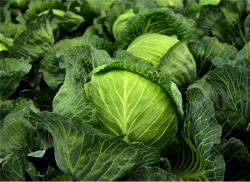
Athanas Tuiyot swapped pen for hoe and has since become a renowned farmer at Chepkanga area in Uasin Gishu County. He shares tips on cabbages.
Seedbed
Identify a good piece of land. Soils with high organic matter yield more. They should also be well-drained with a high water retention capacity. Soil pH should be between 6.5 and 7.0.
Dig up the soil, add manure and DAP fertiliser.
Then dig shallow furrows of less than an inch in depth.
Spray a pesticide since pests could start destroying the seeds immediately after they are planted. Cover seeds lightly with soil and the seedbed with grass.
Water daily before the seeds germinate in five to seven days.
The seedlings are ready for transplanting within four to six weeks.
Transplanting
If for domestic consumption, make holes of 60 by 60 and 60 by 45 if for the market.
An acre of the former can hold up to 15,600 cabbages and 11,700 when using the 60 by 60 spacing. Hypothetically, if you manage to sell the 15,600 cabbages at Sh20, you get Sh312,000 and at Sh80, some Sh1.25 million, within three months.
Put a handful or two of manure in each hole, with about 10gms of DAP in each.
Mix well to avoid ‘burning’ the seedlings.
Harden transplants before planting by reducing water to slow plant growth and increasing light exposure, so that they can withstand the harsh conditions away from the seedbed.
If you plant during the dry season, water two to three times a day for the first five days.
After this, water once a day because within two weeks, the seeds will have been established.
After three weeks, apply CAN and again after another three.
To make good profits, target the dry season, when demand is higher than supply. Prices can range from as low as Sh3 at the farm gate to Sh80 per cabbage depending on timing. Identify your market before harvesting, lest your crop goes to waste.. I have an order for 500 pieces weekly from a school that I supply and get paid Sh20 per piece
Cabbages have a high water requirement, especially during the dry season.
During the first six weeks, each plant needs a litre of water daily and when folding, one-and-a-half litres.
At this stage, a farmer also needs to buy pesticides because this is when the pests are most destructive.
Aphids and diamond back moth are the most destructive because they bore holes in the cabbages.
At five weeks, cutworms, which are the most destructive at this stage, will not destroy them since the young crops will now be hardy.
Cabbages are usually ready at between 75 and 90 days.
Marketing
To make good profits, target the dry season, when demand is higher than supply. Prices can range from as low as Sh3 at the farm gate to Sh80 per cabbage depending on timing. Identify your market before harvesting, lest your crop goes to waste. “I have an order for 500 pieces weekly from a school that I supply and get paid Sh20 per piece,” he says.
